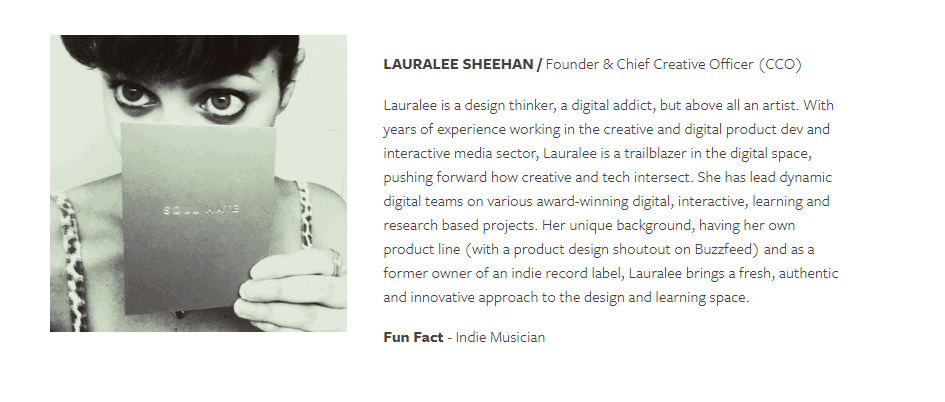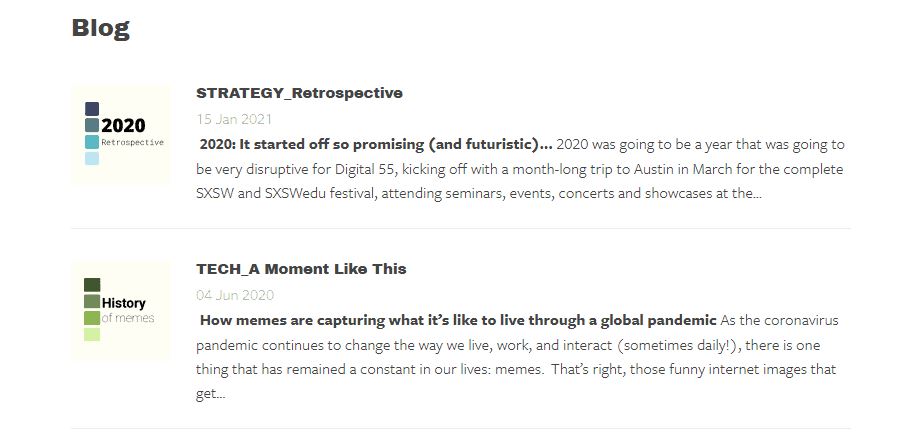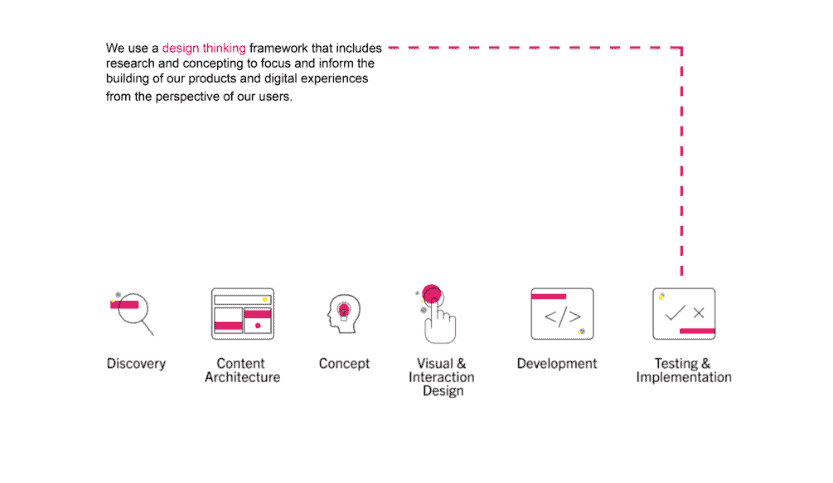Our content is reader supported, which means when you buy from links you click on, we may earn a commission.
Lauralee Sheehan of Digital 55 On Creating ‘Navigating Extraordinary Times’

- Who: Lauralee Sheehan, Chief Creative Officer (CCO)
- Website: Digital 55 Studios
- Course Topic: Leadership in Extraordinary Times
- Interesting Stats: 1500+ Course Completions
Who are you and what course have you created?
Digital 55 is a collective of award-winning designers, developers, researchers, and content producers working together to create unique, innovative digital interactive products and learning experiences.
We work with various not-for-profits, government agencies, and companies on research, user experience, design, dev, content architecture, learning experience design and strategy, and digital interactive storytelling. What makes us most unique is our rebel spirit, rooted in interdisciplinary arts, such as music, film, design, learning, and experiential builds. We are pretty much obsessed with the intersection of creativity and tech.
Drawing on our existing collaboration and partnership with the incredible team at PowerED by Athabasca University, we set out to create a free self-directed online course that could provide leaders with some strategies and frameworks for navigating the current realities and support their transition into the next normal, whatever that may be. Born from our desire to contribute our experience and expertise to answer these important questions, Navigating Extraordinary Times was created.

What market does your online course serve?
Our course is aimed at visionaries. We know first-hand how little time and energy many leaders have at their disposal. They struggle to not only adjust to shifting workplace realities but also shoulder the day-to-day demands of life in isolation and quarantine.
We knew that if the course was to be truly impactful, it couldn’t feel like another thing to add to the list. Rather, the course had to feel fresh, compelling, and modern. To deliver clear takeaways and encourage deep thinking without being obtuse or strenuous. To achieve this, we drew upon an integrated design system with custom animations, original illustrations, interactions, responsive polls, and real-world stories. It’s all delivered in a short, easy-to-digest modular format. This allows leaders to work through the course at their own pace, pursue their own interests, and explore, coming back as often as needed.
What’s the biggest benefit of taking your course?
Everyone is under enormous strain and we have all had to give something up during these difficult times. We wanted to remind leaders that it is perfectly okay to feel whatever they are feeling and let them know that they are not alone in their current struggles. But we also wanted to remind them that just because they may feel powerless in the present moment, it doesn’t mean that they actually are. Through our interactions and activities, we wanted to encourage leaders to focus on the things they can control or influence, and uncover the unexpected opportunities that will help sustain their organizations, teams, and communities into the future.
How did you get into the market?
Digital 55 has been working on interactive digital media, complex storytelling, and digital learning for over a decade and the team brings a very interesting and important interdisciplinary background that defines and informs the way we work and which content we choose to invest in. Collaborators and clients trust us as responsive and curious content producers and interactive digital developers, diving into things that are not neatly packaged and don’t have a clear definition. We’re working on content that speaks to the world, the systems, the experiences, and the changes that are happening so it almost has a bit of a journalistic feeling to how we have built our content architecture.
For myself, my digital career really started from being a musician and playing in a band. We started doing all sorts of modular development and experience design and it iterated into a hardcore digital career from there.

Why did you decide to create an online course in the first place?
Online digital learning has been the subject of a great deal of discussion in the wake of COVID-19. While it is true that the digital learning experience is remarkably different from the one provided in a traditional classroom setting, the reality is that it is the way of the future at least in the sense that it has to intersect and support other means of learning more comprehensively.
Did you have any moments of doubt before you created/launched it?
In those first weeks following the breaking news of a global pandemic and the introduction of physical distancing measures, we here at Digital 55, like so many other businesses, were busy trying to get a handle on what exactly was happening and navigating the new workplace realities introduced by COVID-19. With a heavy heart, we canceled our long-anticipated travel plans for Austin to attend SXSW. We settled into work-from-home routines, applied for available resources and funding, and joined a myriad of webinars. These were all aimed at preparing us for what was to come for businesses and start-ups. All the while still delivering on the pre-COVID projects we’d already had on the go.
We were frustrated, overwhelmed, and saddened by the seemingly sudden turn the world had taken, and we weren’t always certain about how to best move forward. But we were also motivated and inspired by the questions that came to light in the face of the COVID-19 pandemic, questions like:
- What does it mean to authentically connect and empathize with others in the context of physical distancing?
- What do innovation and creativity look like in the midst of such unprecedented restrictions and limitations?
- How does digital tech play a role in building caring, resilient, and psychologically safe communities and workplaces, both for today and tomorrow?
If so what made you turn it around and do it anyway?
At Digital 55, we have always been optimistic about the power of digital tech to facilitate engaging, meaningful learning experiences; to disseminate knowledge to wide-spread audiences, spark interest and curiosity, encourage critical thinking, and ultimately support actionable change for learners of all levels.
That purpose was the driving force to push through the anxiety about researching and creating content on an evolving lived human experience with the risks for society escalating at a rapid pace. Mental health is deteriorating, stress levels are going up, people are losing everything they have worked for, routines and community supports are inaccessible. Some industries are really, really struggling, and suffering. Leading a team or running a business through all this is intense, stressful, and heartbreaking. There are just no two ways about it.
What’s your online course like?
The course had to feel fresh, compelling, and modern, delivering clear takeaways and encouraging deep thinking without being obtuse or strenuous. To achieve this, we drew on an integrated design system for a modular digital build with custom animations, original illustrations, audio spotlights, interactions, responsive polls, and real-world stories—all delivered in a short, easy-to-digest modular format that allows leaders to work through the course at their own pace, pursue their own interests, and explore, coming back as often as needed.
How long did it take you to create your course?
This was a rapid build. Because we were responding to the pandemic and immediate needs of leaders, we created this course from idea to content to design/dev to deployment within a six week period. It was crunchy.
With just-in-time-learning, content is provided at the exact time and by the exact means necessary to satisfy the intended learner’s needs. - Lauralee Sheehan Click To TweetThis means successfully anticipating needs that may still be in the formative stages – a task that can feel difficult at the most predictable of times, and nearly impossible in the context of an unprecedented global health crisis. As we rushed to meet our ambitious project timelines, we often found that what we thought leaders would need to be had already shifted in light of new information or developments. We had to remain agile in our approach and committed to our overall vision while still staying flexible enough to fine-tune and course-correct as needed along the way.

What’s the traffic strategy that works best for you?
We always work with clients or distributors so we act more like content and digital media producers for original content. We are platform agnostic but continuously see different platforms from a UX perspective through our clients and collaborators environments.
What other tools do you use to run your online course business?
At Digital 55, we use a trifecta of tools in our digital learning “dev kit” and they are all equally as important for us when creating immersive, modular digital learning experiences.
- On the content side, we depend on super collaborative and real-time tools. We lean on Google Suite and InVision freehand to run collaborative brainstorms and content creation at the front end of projects.
- On the creative direction and design/media side, we use the complete Adobe Creative Suite from After Effects for video editing and compositing. Photoshop, Illustrator, or XD for asset creation. InDesign for handbooks and PDFs, Audition for a podcast, or audio editing. We also use InVision concept boards for early creative direction. This also keeps the learning experience (LX) style guide digital and accessible to all collaborators.
- On the dev side when it comes to e-learning, Articulate is our main and trusted authoring tool. You can do rapid dev that looks very web-based and modern with Rise. You can get creative on the UX side with the 360° integration for nice interactions that sit within a body section and can go very immersive and exploratory on the user experience side. There is also great media embed functionality and of course. The exports through these tools can live on the web or on an LMS. This is great for releases and engaging in the right way with the audience.
What books or training programs have you found useful on your journey to a successful business owner that others might find valuable too?
Any focus you have on things that inspire you is going to translate to your success as a business owner. For instance, I am a huge film and music buff, and sometimes watching the latest film by, say David Fincher, is going to get me away from the mechanics of entrepreneurship and tune into that high-level thinking that is the super-powerful, valuable part.
You have to care about what you are doing. Not just from a business perspective but from a human experience and social sustainability perspective. Invest in things that inspire you with no inhibitions. That will come back to you tenfold. Also, these days, there is so much content available for entrepreneurs. Whether it be books, podcasts, or YouTube segments with information on ways to think about running a business. I would say explore it all!
Here are a few keys resources that I’ve been leaning into recently:
- StartUp Podcast by Gimlet Media (some amazing case studies and storytelling on things entrepreneurs go through)
- The Future Podcast (design-focused but also entrepreneurial focused)
- Fast Company Magazine (love the innovation and futurism focus of this publication)
- NextMapping (a book about the future of work, just digging in so no thoughts yet but interested)
- Disrupt it Yourself

Do you have any big mistakes you’ve made along the way that you’d be willing to share?
Where to start? Entrepreneurship is messy and chaotic but also empowering and inspiring. I constantly make mistakes, it’s part of the deal.
When you create things from scratch and build a company, there are rules and no rules at the same time. - Lauralee Sheehan Click To TweetYou have to take chances and take risks and that can lead to mistakes in that process. Luckily nothing major but as we are scaling and growing, we have to take on bigger projects. We do struggle to scale our capacity as quickly. We’re still lean and agile. So it’s a constant learning curve. It can be very humbling when you are trying to maintain the integrity of the contract, handle intense and rapid release timelines, make sure your team is supported and you do have enough people involved to realistically develop everything that is needed.
Please share some idea of revenue.
Even though Navigating Extraordinary Times was offered to learners for free, in recent years, educational technology, or edTech, has emerged as one of the most promising sectors within the interactive content market, with considerable potential outside traditional classrooms. Consumers, in general, are subscribing and accessing digital learning materials in their off-hours at accelerated rates. From massive open online courses (MOOCs), language-learning programs, and brain training games, to TED Talks and education podcasts. The rising popularity of interactive digital educational products corresponds to a similar trend in media. That’s where user-driven, non-linear storytelling is being embraced as a primary digital strategy. We expect to continue to see exponential growth for digital learning products!
Please tell us a little about what the money you’ve earned from your course has done for you.
Content producing and creating digital learning experiences has allowed the business to grow very rapidly! We’ve been able to build our team and invest in a badass office in an extremely important innovation hub in Toronto. We’ve also invested in our own original IP and support thought leadership and innovation in the digital learning and interactive digital media space.
In addition to revenue are there any numbers you would like to share?
The exact number of people who have taken the course to date since its launch in May 2020 is kept with Athabasca University. But we know that it totals over at least 1500 successful course completions.
Here’s what those who have completed Navigating Extraordinary Times are saying:
“I found the design to be one of the best I have seen so far, if not the overall best!”
“This was the best content I have experienced so far. Love hearing about psychological safety, vulnerability, helping leaders to lead. Excellent course!”
“The supporting videos and articles gave tangible takeaways that I will be able to implement immediately in both my personal and professional life.”

What has creating your course done for you personally?
This pandemic really highlights that we have to look at the systems that have gotten us here. We have to break those apart. Normally, focus on human-centered design, a design approach that takes the human perspective into account. But, presently, I have to think beyond that because humanity’s perspective is frayed. Humans are going through a lot, on a collective and individual level. There’s the pandemic. Then there’s also the social disparities and injustices. These are not new in the world but have become even more amplified and intensified as a result.
Right now, experience designers and content/media creators have this great opportunity to think disruptively and creatively. It’s an opportunity to examine all the different intersecting systems that shape our world. We can redesign them for the next chapter. As society moves to a more digital model, we can re-think what that future looks like. Then craft the world we wish to see. From work to health care, to social justice, to the environment.
For me, the priority is to unify society by advocating for equity. Plus the inclusion of multiple voices and perspectives. And global access to knowledge and to start enacting some major change for the future. And by the way, the future is now.
Do you have a story of a transformation from any of your clients?
We really believe in collaboration and being responsive to issues and topics that are happening in the world. This means that sometimes you have nothing to lean on but a notion or a “good idea.”We have to dive into research on moving target subject matter. It’s risky but we’ve been honored to move into not only a trendcaster of what needs to be discussed but key original content producers with one of our clients. We’ve been able to disrupt the service model quite a bit and make collaboration a really key component of next-level digital learning experiences.
What advice do you have for people just starting out?
Start! People tend to wait for these perfect moments when it comes to big changes or risky ventures.
You wait for the “perfect” moment but sometimes getting started is better than perfect. - Lauralee Sheehan Click To TweetI was really inspired by the book “The $100 Startup” and I think that approach is a very good one. Build and iterate as you go. Don’t wait until you have a 50-page business plan or a certain amount of money in the bank. There is never going to be the best time. So in theory or if we are waxing philosophical, the best time is now!
Learn More about Lauralee Sheehan of Digital 55:
- Website: Digital 55